Test Weight
Test weight (weight per volume) is a measure of bulk density and is often used as a general indicator of overall quality and as a gauge of endosperm hardness for alkaline cookers and dry millers. High test weight corn takes up less storage space than the same weight of corn with a lower test weight. Test weight is initially impacted by genetic differences in the structure of the kernel. However, it is also affected by moisture content, method of drying, physical damage to the kernel (broken kernels and scuffed surfaces), foreign material in the sample, kernel size, stress during the growing season, kernel maturity, kernel hardness and microbiological damage. Test weight is often positively correlated with true density. High test weight at the export point generally indicates high quality, a high percent of horneous (or hard) endosperm and sound, clean corn.
Results
- Average U.S. Aggregate test weight (57.4 lb/bu or 73.9 kg/hl), well above the limit for U.S. No. 1 grade (56.0 lb/bu), was the same as 2016/2017, and similar to 2015/2016 (57.3 lb/bu) and 5YA (57.5 lb/bu). Test weight at export has been within ±0.2 lb/bu for the past 3 years and 5YA.
- The 2017/2018 export samples had more variation, as indicated by the higher standard deviation (0.85 lb/bu), than 2016/2017 (0.61 lb/bu) and 5YA (0.79 lb/bu). The range in values was also greater in 2017/2018 (6.9 lb/bu) than in 2016/2017 (4.5 lb/bu) and 2015/2016 (6.4 lb/bu).
- Test weight for 83.8% of the samples was at or above the minimum for U.S. No. 1 grade (56.0 lb/bu), and 100% of the samples were at or above the limit for U.S. No. 2 grade (54.0 lb/bu).

- Average U.S. Aggregate test weight at export (57.4 lb/bu or 73.9 kg/hl) was lower than at 2017 harvest (58.4 lb/bu or 75.2 kg/hl). Average test weight at export has been consistently lower than at harvest, as indicated by export 5YA (57.5 lb/bu or 74.0 kg/hl) and harvest 5YA (58.1 lb/bu or 74.8 kg/hl).
- The 2017/2018 export samples’ variability (standard deviation of 0.85 lb/bu) was lower than the 2017 harvest samples (1.21 lb/bu). As corn is commingled moving through the market channel, test weight becomes more uniform, with a lower standard deviation and a smaller range between maximum and minimum values than at harvest. At export, 5YA standard deviation was 0.79 lb/bu, compared with harvest 5YA standard deviation of 1.27 lb/bu.
- Average test weight was higher for the Southern Rail ECA (58.2 lb/bu) than for the Pacific Northwest (55.6 lb/bu) and the Gulf (57.8 lb/bu) ECAs.
- Average test weight of corn for contracts loaded as U.S. No. 2 o/b (57.4 lb/bu) was the same as contracts loaded as U.S. No. 3 o/b (57.4 lb/bu). Averages for both contracts were above the limit for U.S. No. 1 grade.
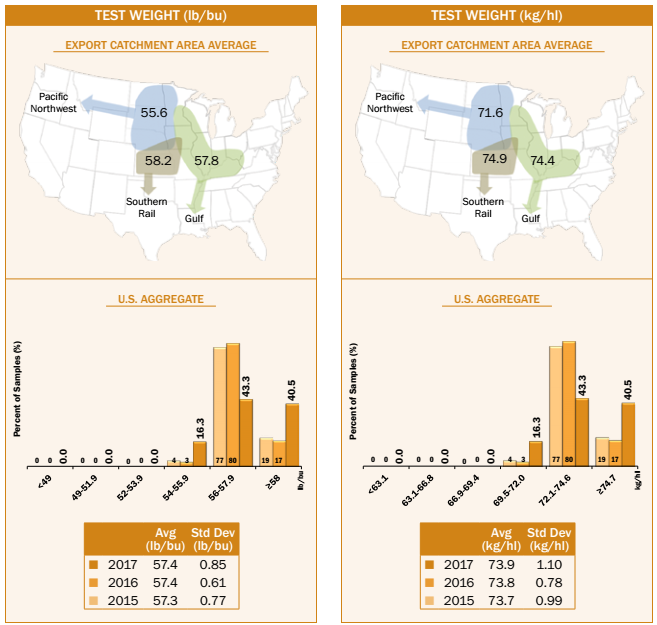
Broken Corn and Foreign Material (BCFM)
Broken corn and foreign material (BCFM) is an indicator of the amount of clean, sound corn available for feeding and processing. The lower the percentage of BCFM, the less foreign material and/or fewer broken kernels are in the sample. As corn moves from farm deliveries through the market channel, each impact on the grain during handling and transporting increases the amount of broken corn. As a result, the average BCFM in most shipments of corn will be higher at the export point than in deliveries from the farm to the local elevator.
Broken corn (BC) is defined as corn and any other material (such as weed seeds) small enough to pass through a 12/64th-inch round-hole sieve, but too large to pass through a 6/64th-inch round-hole sieve.
Foreign material (FM) is defined as any non-corn material too large to pass through a 12/64th-inch round-hole sieve, as well as all fine material small enough to pass through a 6/64th-inch round-hole sieve. Thus, FM consists of Coarse Foreign Material (CFM) retained on the 12/64th-inch sieve and fine material passing through the 6/64th-inch sieve. CFM is primarily non-grain material, and fine material is largely composed of corn dust and weed seeds. Loading, transport and discharge cannot alter CFM, but impacts during loading and discharge will increase BC and fines.
The diagram below illustrates the measurement of broken corn and foreign material for the U.S. corn grades.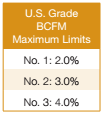
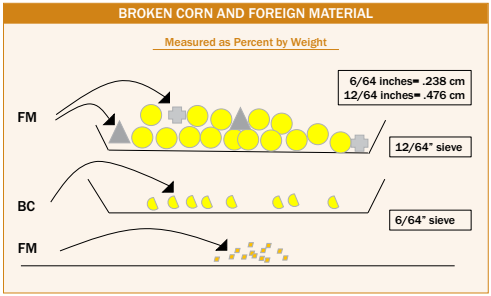
Results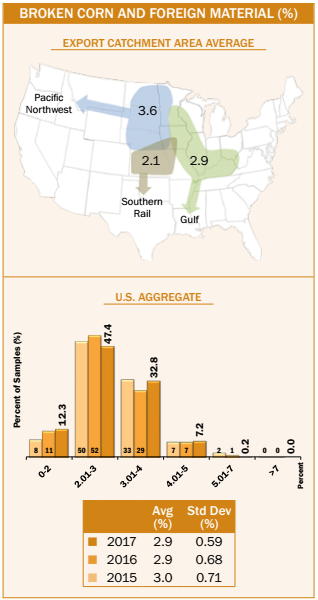
- Average U.S. Aggregate BCFM in export samples (2.9%) was the same as 2016/2017 and 5YA, but slightly lower than 2015/2016 (3.0%). Average BCFM was below U.S. No. 2 grade limit (3.0%). Average BCFM at export has been within ±0.1 percentage point for the past 3 years and the 5YA, indicating the ability of exporters to consistently manage the cargo to meet importers’ specifications.
- The variability of the 2017/2018 export samples (with a standard deviation of 0.59%) was lower than 2016/2017 and 5YA (both 0.68%). The range in values (4.9%) was less than in 2016/2017 (6.0%) and 2015/2016 (10.5%).
- BCFM in the 2017/2018 export samples was distributed with 59.7% of the samples at or below the limit for U.S. No. 2 grade (3.0%), and 92.5% at or below the limit for U.S. No. 3 grade (4.0%).
- Average U.S. Aggregate BCFM at export (2.9%) was 2.1 percentage points higher than at harvest (0.8%). This increase is the same as the 5YA increase of 2.1 percentage points (harvest 5YA was 0.8% compared with export 5YA of 2.9%). This increase is likely a result of drying and increased breakage that occurs with additional impacts caused by conveying, dropping and handling.
- Average Southern Rail ECA BCFM (2.1%) was lower than either the Gulf (2.9%) or Pacific Northwest (3.6%) ECAs. Average BCFM for the Southern Rail ECA has also been lowest among the ECAs for the previous two years and 5YA.
- Average BCFM for contracts loaded as U.S. No. 2 o/b was 2.8%, compared with the average BCFM of 3.0% for contracts loaded as U.S. No. 3 o/b. Corn arriving at the export point is normally commingled from many origins and cleaned to meet the limits for the contracted grade.
Total Damage
Total damage is the percentage of kernels and pieces of kernels that have visually observable damage, including damage from heat, frost, insects, sprouting, disease, weather, ground, germ and mold. Most of these types of damage result in some sort of discoloration or change in kernel texture. Damage does not include broken pieces of grain that are otherwise normal in appearance. Mold damage and the associated potential for mycotoxins is the damage factor of greatest concern. Mold damage is often associated with plant stress during the growing season or high moisture and temperature conditions during storage or transport.
Corn with low levels of total damage is more likely to arrive at destination in good condition than corn with high levels of total damage. Samples with high levels of total damage have the potential for further microbiological activity, which may increase moisture content and grain temperatures during storage or transport.
Results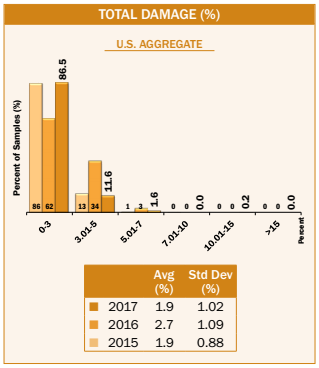
- Average U.S. Aggregate total damage (1.9%) was lower than 2016/2017 (2.7%) and 5YA (2.1%), and still below the limit (3.0%) for U.S. No. 1 grade.
- Variability in the 2017/2018 samples, as indicated by the standard deviation (1.02%), was similar to 2016/2017 (1.09%) and 5YA (1.05%). However, the 2017/2018 sample range (0.0 to 10.4%) was greater than the 2016/2017 range (0.1 to 6.8%).
- Of the export samples, 86.5% had 3.0% or less damaged kernels, meeting the requirement for U.S. No. 1 grade. In addition, 98.1% were at or below the limit for U.S. No. 2 grade (5.0%).
- The average level of total damage in the market channel at export (1.9%) was higher than that at harvest (1.3%). The increase in total damage from the 2017 harvest to the 2017/2018 exports is similar to changes seen in previous years. Export 5YA (2.1%) was higher than harvest 5YA (1.5%), for a difference of 0.6 percentage points. Total damage can increase during storage, especially if there are spout lines and pockets of high moisture in the storage bins or in the transport containers.
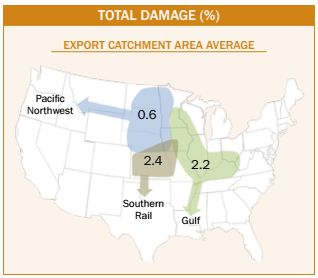
- The Pacific Northwest ECA had lower average total damage (0.6%) than the Gulf (2.2%) and the Southern Rail (2.4%) ECAs. The Pacific Northwest ECA also had the lowest average total damage among the ECAs for 2016/2017, 2015/2016 and 5YA.
- Average total damage for contracts being loaded as U.S. No. 2 o/b (2.0%) and as U.S. No. 3 o/b (1.5%) were below the limit for U.S. No. 1 grade (3.0%).
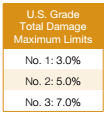
Heat Damage
Heat damage is a subset of total damage in corn grades and has separate allowances in the U.S. grade standards. Heat damage can be caused by microbiological activity in warm, moist grain or by high heat applied during drying. Low levels of heat damage may indicate the corn has been dried and stored at moisture contents and temperatures that prevent damage in the market channel.
Results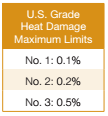
- Average U.S. Aggregate heat damage was 0.0%, the same as 2016/2017, 2015/2016 and 5YA. These averages have also been well below the limit for U.S. No. 1 grade in previous years, indicating good management of drying and storage of the corn throughout the market channel.
- Only four samples in the entire 2017/2018 export cargo sample set (total of 430 samples) showed any heat damage (0.1, 0.1, 0.2 and 0.2%).
